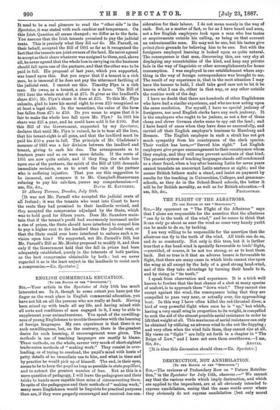THE FLIGHT OF THE ALBATROSS.
[To THE EDITOR OF THE 4. SPECTAT012."]
Sia,—My opponent on " The Flight of the Albatross " says that I alone am responsible for the assertion that the albatross " can fly in the teeth of the wind," and he seems to think that it can only go about as near the wind as some very handy yacht can be made to do so, by tacking.
I am very willing to be responsible for the assertion that the albatross can fly in the teeth of the wind. All birds can do so, and do so constantly. Not only is this true, but it is farther
true that a due head-wind is specially favourable to birds' flight,. —provided, of course, it be not too strong, so as to beat them
back. Bat so true is it that an adverse breeze is favourable to flight, that there are many cases in which birds cannot rise upon the wing at all except by the help of a good strong head-wind, and of this they take advantage by turning their heads to it, and by rising in "its teeth."
I speak from observation and experience. It is a trick well known to fowlers that the best chance of a shot at many species of seafowl, is to approach them "down wind." They cannot rise except against the wind, the consequence being that they are compelled to pass very near, or actually over, the approaching boat. In this way I have often killed the red-throated diver, a bird of very powerful flight when once he is "up," but whioh, having a very small wing in proportion to its weight, is compelled to seek the aid of the utmost possible aerial resistance in order to lift that weight at all. This maximum of aerial resistance can only be obtained by utilising an adverse wind to eke out the flapping ; and very often when the wind fails them, they cannot rise at all. My views on "flight" are fully set forth in a chapter in " The Reign of Law," and I have not seen them overthrown.—I am, Sir, &c., Airman [It is time this discussion should close.—En. Spectator.]


































 Previous page
Previous page